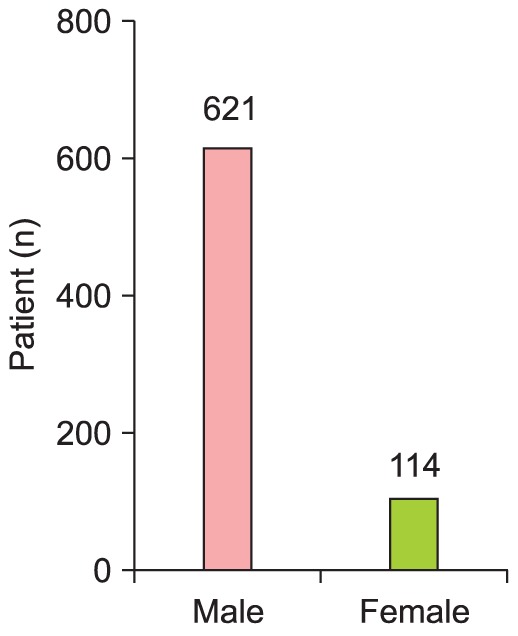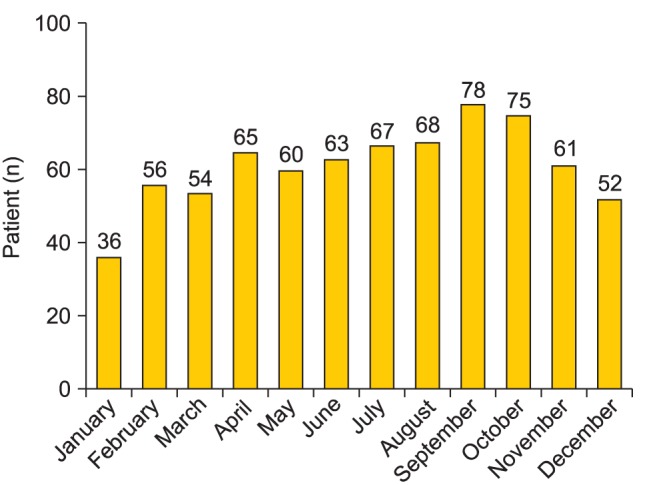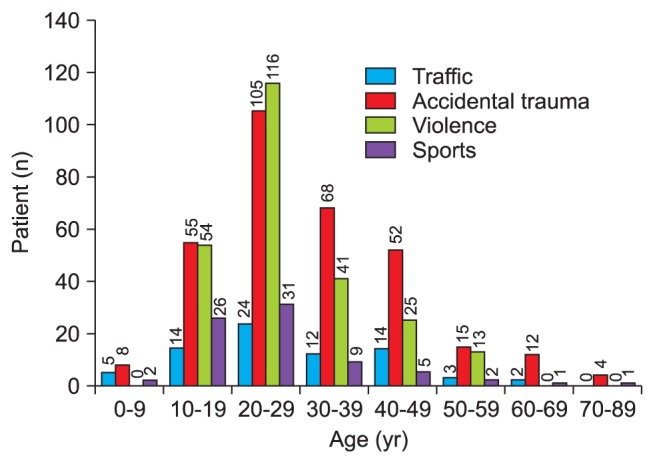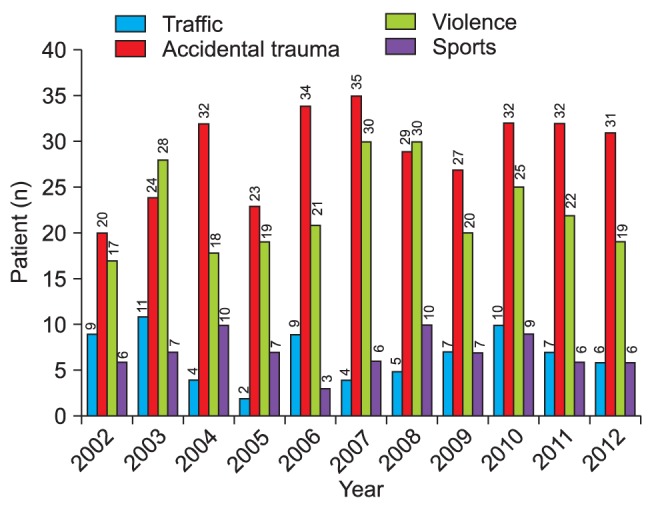J Korean Assoc Oral Maxillofac Surg.
2014 Feb;40(1):21-26. 10.5125/jkaoms.2014.40.1.21.
Retrospective clinical study of mandible fractures
- Affiliations
-
- 1Department of Oral and Maxillofacial Surgery, School of Dentistry, Kyung Hee University, Seoul, Korea. ojyoung81@hanmail.net
- KMID: 1960968
- DOI: http://doi.org/10.5125/jkaoms.2014.40.1.21
Abstract
OBJECTIVES
The purpose of this article is to analyze the incidence, demographic distribution, type, and etiology of mandible fractures that were treated by the Department of Oral and Maxillofacial Surgery in Kyung Hee University Dental Hospital from January 2002 to December 2012.
MATERIALS AND METHODS
This was a descriptive and analytic retrospective study that evaluated 735 patients that were treated for mandible fracture.
RESULTS
This study included 1,172 fractures in 735 patients. The ratio of male to female patients was 5.45 : 1; the maximum value was in patients between 20 and 29 years (38.1%) and the minimum in patients over 70 years old. The monthly distribution of facial fractures peaked in the fall and was lower during winter. No specific correlation was identified based on the annual fracture distribution. Among the 735 fracture patients, 1.59 fracture lines were observed per patient. The most frequent site was the symphysis, which accounted for a total of 431 fractures, followed by the angle (348), condyle (279), and body (95). The symphysis with angle was the most common site identified in combination with fracture and accounted for 22.4%, followed by symphysis with condyle (19.8%). The angle was the most frequent site of single fractures (20.8%). The major cause of injury was accidental trauma (43.4%), which was followed by other causes such as violence (33.9%), sports-related accidents (10.5%), and traffic accidents (10.1%). Fracture incidents correlated with alcohol consumption were reported between 10.0%-26.9% annually.
CONCLUSION
Although mandible fracture pattern is similar to the previous researches, there is some changes in the etiologic factors.
Keyword
MeSH Terms
Figure
Cited by 2 articles
-
A retrospective analysis of mandibular fractures in Mewat, India
Vijay Laxmy Malhotra, Amita Sharma, Rajiv Tanwar, Meenu Dhiman, Radhey Shyam, Depinder Kaur
J Korean Assoc Oral Maxillofac Surg. 2021;47(5):365-372. doi: 10.5125/jkaoms.2021.47.5.365.A retrospective study of mandibular fractures in children
Santanu Mukhopadhyay
J Korean Assoc Oral Maxillofac Surg. 2018;44(6):269-274. doi: 10.5125/jkaoms.2018.44.6.269.
Reference
-
1. Nam KY, Park IS, Kim JB. Retrograde clinical study of mandible bone fracture. Keimyung Med J. 2006; 25:29–38.2. Zix JA, Schaller B, Lieger O, Saulacic N, Thorén H, Iizuka T. Incidence, aetiology and pattern of mandibular fractures in central Switzerland. Swiss Med Wkly. 2011; 141:w13207. PMID: 21618147.
Article3. Dongas P, Hall GM. Mandibular fracture patterns in Tasmania, Australia. Aust Dent J. 2002; 47:131–137. PMID: 12139266.
Article4. van den Bergh B, Karagozoglu KH, Heymans MW, Forouzanfar T. Aetiology and incidence of maxillofacial trauma in Amsterdam: a retrospective analysis of 579 patients. J Craniomaxillofac Surg. 2012; 40:e165–e169. PMID: 21917471.
Article5. Erol B, Tanrikulu R, Görgün B. Maxillofacial fractures. Analysis of demographic distribution and treatment in 2901 patients (25-year experience). J Craniomaxillofac Surg. 2004; 32:308–313. PMID: 15458673.6. Paes JV, de Sá Paes FL, Valiati R, de Oliveira MG, Pagnoncelli RM. Retrospective study of prevalence of face fractures in southern Brazil. Indian J Dent Res. 2012; 23:80–86. PMID: 22842255.
Article7. Pombo M, Luaces-Rey R, Pértega S, Arenaz J, Crespo JL, García-Rozado A, et al. Review of 793 facial fractures treated from 2001 to 2008 in a coruña university hospital: types and etiology. Craniomaxillofac Trauma Reconstr. 2010; 3:49–54. PMID: 22110818.
Article8. Chung IH, Han KD, Suh JD, Hwang KG. Etiology and patterns of mandibular fractures. J Korean Assoc Maxillofac Plast Reconstr Surg. 2005; 27:472–477.9. Natu SS, Pradhan H, Gupta H, Alam S, Gupta S, Pradhan R, et al. An epidemiological study on pattern and incidence of mandibular fractures. Plast Surg Int. 2012; 2012:834364. PMID: 23227327.
Article10. Lee DK, Oh SH, Sung HM, Kim YW, Kwon KH. The clinicostatistical study of facial bone fracture in recent five years. J Korean Assoc Oral Maxillofac Surg. 1998; 24:448–453.11. O'Meara C, Witherspoon R, Hapangama N, Hyam DM. Alcohol and interpersonal violence may increase the severity of facial fracture. Br J Oral Maxillofac Surg. 2012; 50:36–40. PMID: 21145631.12. O'Meara C, Witherspoon R, Hapangama N, Hyam DM. Mandible fracture severity may be increased by alcohol and interpersonal violence. Aust Dent J. 2011; 56:166–170. PMID: 21623808.13. Lee SC, Kim YG, Ryu DM, Oh SH. A clinical study of facial bone fractures for the last 5 years. J Korean Assoc Oral Maxillofac Surg. 1991; 17:40–45.
- Full Text Links
- Actions
-
Cited
- CITED
-
- Close
- Share
- Similar articles
-
- Pathologic Fractures of the Mandible
- A CLINICAL AND STATISTICAL STUDY OF CONDYLAR FRACTURE OF MANDIBLE
- Surgical Management of Edentulous Atrophic Mandible Fractures in the Elderly
- The Usefulness of Mandible CT Scanning in the Diagnosis and Treatment of Mandible Fracture
- The Use of Miniplates for Treatment of Mandibular Fractures








